|
|
|
Sort Order |
|
|
|
Items / Page
|
|
|
|
|
|
|
| Srl | Item |
| 1 |
ID:
118661
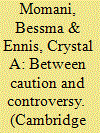

|
|
|
|
|
| Publication |
2012.
|
| Summary/Abstract |
The history of Gulf donorship, its trajectory and underlying motivations, continues to be an understudied aspect of foreign aid. While the Gulf Arab states are not new donors, their manner of regional coordination, branding, and aid management are distinct. Often helping fellow countries of the South, particularly Arab and Muslim countries, these countries have moved towards stronger private sector involvement and into social spending programmes. Owing to their oil wealth, Gulf Arab states' are increasingly generous and yet they are also cautious after 9/11 about how and by whom their aid is channelled. Nevertheless, with oscillations in oil prices, continued controversy over rising Islamism post-Arab-Spring, the future of Gulf aid remains a valuable subject of study.
|
|
|
|
|
|
|
|
|
|
|
|
|
|
|
|
| 2 |
ID:
118657
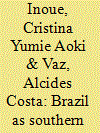

|
|
|
|
|
| Publication |
2012.
|
| Summary/Abstract |
This article analyses Brazil's growing role in external development assistance. During Lula da Silva's presidency, cooperation with developing countries grew dramatically. While the official position is that Brazilian development assistance is moved not by national economic or political interests, but by international 'solidarity', and does not reproduce the North-South traditional aid relations, we suggest that it is not completely divorced from national, sub-national or sectoral interests and cannot be viewed apart from Brazil's broader foreign policy objectives. Brazil does pursue political, economic and commercial interests and, concomitantly, has made a positive difference in the recipient countries. However, more empirical research and field investigation are needed to better gauge the impact of Brazil's assistance initiatives and their contributions to South-South cooperation more broadly. During Lula's terms (2003-2010), Brazil could be classified as a 'Southern donor', which expresses the country's own novelties, and tensions, of simultaneously being a donor and a developing country.
|
|
|
|
|
|
|
|
|
|
|
|
|
|
|
|
| 3 |
ID:
118660
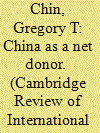

|
|
|
|
|
| Publication |
2012.
|
| Summary/Abstract |
The article examines China's emergence over the past decade as a net donor, and the implications of this status in global development. The analysis begins by outlining China's rise as a net donor, drawing comparisons in two-way aid flows with the other rising states, specifically Brazil, South Africa and India, and then turns to the implications of China's rise as an aid sender. The central argument is that conceptualizing China's rise as a 'net donor' is crucial for understanding the hybrid position that China has come to occupy in the global aid system, and the consequences of this positioning. Although China has achieved remarkable success with its own development, rather than join the Organization for Economic Cooperation and Development's Development Assistance Committee (DAC) regime of traditional donors, the Chinese Communist Party and government leadership has chosen instead to continue to self-identify with the countries of the South, and to construct ties of South-South cooperation outside of DAC arrangements. The Chinese leadership is trying to stake out an unprecedented position in the global aid system, traversing the North-South divide, despite the fact that China has already joined the ranks of world economic powers.
|
|
|
|
|
|
|
|
|
|
|
|
|
|
|
|
| 4 |
ID:
118663
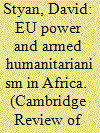

|
|
|
|
|
| Publication |
2012.
|
| Summary/Abstract |
This article analyses the European Union's (EU's) largest European Security and Defence Policy (ESDP) military mission outside Europe to date; Eufor Tchad/RCA was a 3700-strong force involving personnel from 23 states, deployed to Chad and the Central African Republic for 12 months from March 2008. Far from this mission achieving EU 'supremacy' or projecting an 'imperial' reach, an evaluation of its objectives and achievements reveals acute limitations in the EU's ability to project power. The article analyses the context in which Eufor was conceived and deployed. It notes that the mission's weaknesses, like those of the United Nations mission to whom the EU transferred its security role in 2009, reflected its convoluted origins and objectives. Finally, the article examines whether the EU as a unitary actor has the desire or the ability to 'replace' individual European nations-in this case France-in their post-colonial military and 'humanitarian' roles in sub-Saharan Africa.
|
|
|
|
|
|
|
|
|
|
|
|
|
|
|
|
| 5 |
ID:
118659
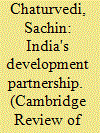

|
|
|
|
|
| Publication |
2012.
|
| Summary/Abstract |
This article examines the emerging trends in India's role as a provider of development assistance to the other developing countries of the global South. Though India has diversified the regional focus and has multiplied the quantum of development assistance, there remain several challenges at various levels. The expectations from the development partners have gone up but is India prepared with the institutional frameworks that would be required to administer the desired scale of response? Is there enough preparedness to undertake impact assessment? This article attempts to address some of these issues.
|
|
|
|
|
|
|
|
|
|
|
|
|
|
|
|
| 6 |
ID:
118662


|
|
|
|
|
| Publication |
2012.
|
| Summary/Abstract |
In recent years a number of countries have established more prominent development assistance programmes. These 'emerging donors' are generally low- and middle-income countries with fewer links than traditional donors to multilateral frameworks for coordination. This article focuses primarily on whether these increasingly important donors will converge upon or challenge the behavioural norms that have emerged from traditional donor operations. It offers two main findings. First, although the evidence is incomplete, it suggests that the group of emerging donors is too heterogeneous to pose a collective alternative to the existing aid architecture, though these states may well provide new insights to enrich and improve our understanding and practice of development assistance. Second, it suggests that the case of Russia as a re-emerging donor highlights the conceptual weaknesses of theorizing simply in terms of 'emerging donors' versus 'traditional donors'.
|
|
|
|
|
|
|
|
|
|
|
|
|
|
|
|
| 7 |
ID:
118664


|
|
|
|
|
| Publication |
2012.
|
| Summary/Abstract |
Several scholars have suggested that ASEAN's institutionalization can be attributed to the EU's influence as a 'model power'. The notion of the EU as a model power is premised on the assumption and belief that Europe's history of regional cooperation presents a viable blueprint for other regions. This article argues that the EU exerts some power over ASEAN-but merely as a 'reference point'. The EU's influence is not an active one; the organisation essentially serves as a passive reference point for ASEAN. The obvious and arguably most important example of this referencing is the framing of the ASEAN Charter in 2007. This article disagrees with scholars who reduce ASEAN's institutionalization to an imitation of the EU form without the substance. Instead, it shows how ASEAN has innovated as a regional organization through its Charter and Intergovernmental Human Rights Commission.
|
|
|
|
|
|
|
|
|
|
|
|
|
|
|
|
| 8 |
ID:
118656


|
|
|
|
|
| Publication |
2012.
|
| Summary/Abstract |
There is general consensus in scholarly and policy circles that the global aid regime is undergoing major changes. Analysts have examined the emerging trends in development cooperation, and have identified the 'emerging donors' and other 'non-DAC [Development Assistance Committee] donors' as the source of important quantitative shifts in global aid flows (Manning 2006). Some scholars have described systemic fracturing in the established global aid regime (Woods 2008), while others have discussed the declining effectiveness of the traditional donors, a weakening of the so-called 'Washington Consensus' or the decline in the conventional structures of the aid delivery mechanism led by the Organization of Economic Cooperation and Development (OECD) DAC (Lancaster 2007; Birdsall and Fukuyama 2011; Chaturvedi et al 2012). There is a burgeoning literature around the impact of the rising states on Africa, in trade, aid and investment, society and politics, especially China's impact (Taylor 2006; 2008; Alden 2007; Rotberg 2008; De Haan 2010; Krageland 2011). Yet much is to be done in terms of systematically and critically analysing the details of the policy intentions, political-economic motivations and programing objectives of the BRICS (Brazil, Russia, India, China and South Africa) as aid providers and their impact on the less developed countries.
|
|
|
|
|
|
|
|
|
|
|
|
|
|
|
|
| 9 |
ID:
118658
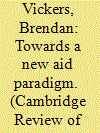

|
|
|
|
|
| Publication |
2012.
|
| Summary/Abstract |
As the largest African economy and the leading African aid-provider, with plans to establish an aid agency, South Africa is often ranked among the developing world's 'emerging donors'. However, the country's development cooperation commitments are smaller in scope, scale and ambition than the aid regimes of the BRIC (Brazil, Russia, India, China) or Gulf state donors. Given its limited resources and domestic socioeconomic challenges, South Africa prefers the role of 'development partner'. In this role, South Africa's development cooperation in Africa has ranged from peacekeeping, electoral reform and post-conflict reconstruction to support for strengthening regional and continental institutions, implementing the New Partnership for Africa's Development (NEPAD) and improving bilateral political and economic relations through dialogue and cooperation. This article seeks to determine whether Pretoria's development cooperation offers an alternative perspective to the aid policies and practices of the traditional and large rising donors. We conclude that South Africa does not fit neatly the 'donor' category of the Organization for Economic Cooperation and Development's (OECD's) Development Assistance Committee (DAC) and neither is Pretoria's aid-spending typically 'ODA' (official development assistance). Instead, with its new aid agency, South Africa occupies a unique space in Africa's development cooperation landscape. With fewer aid resources, but a 'comparative advantage' in understanding Africa's security/governance/development nexus, South Africa can play an instrumental role in facilitating trilateral partnerships, especially in Southern Africa.
|
|
|
|
|
|
|
|
|
|
|
|
|
|
|
|
|
|
|
|
|